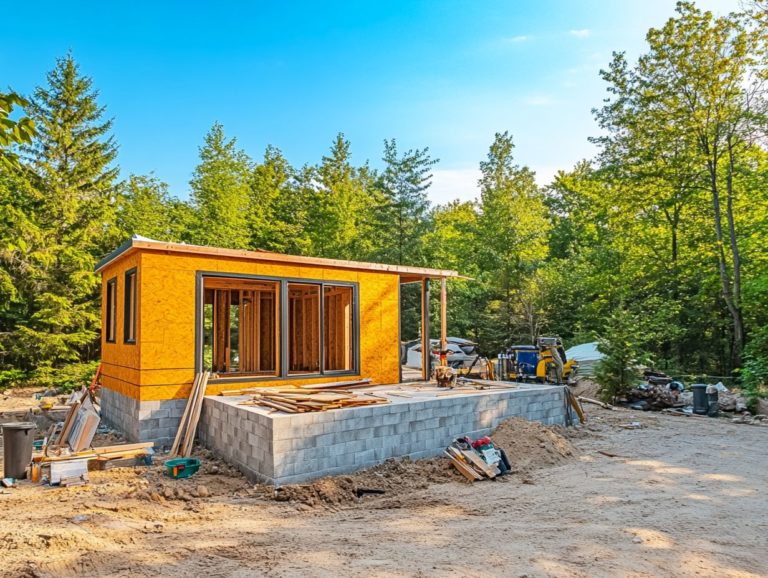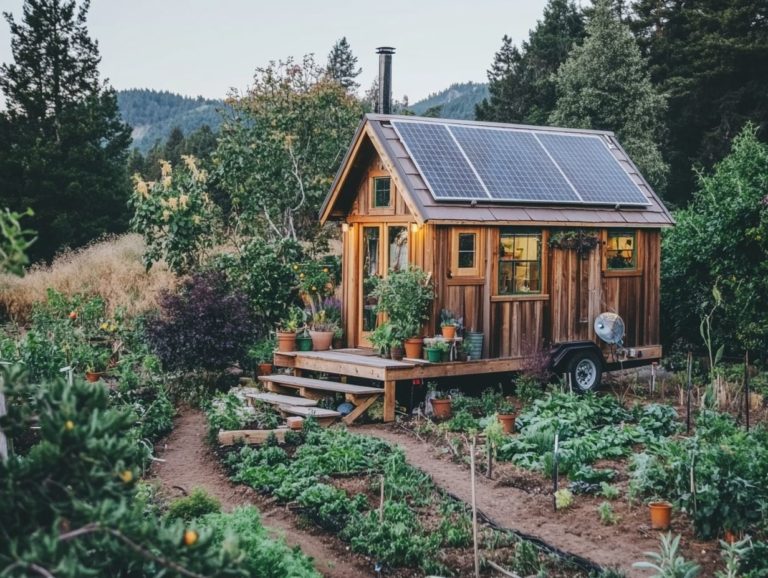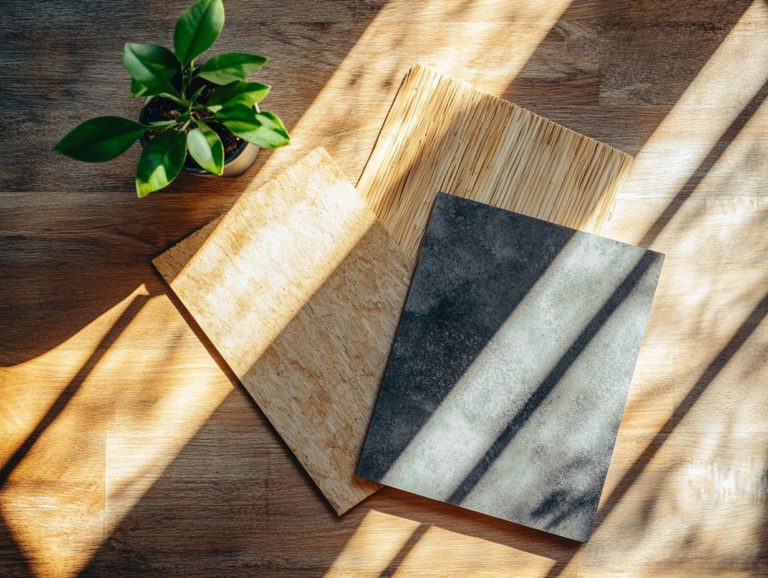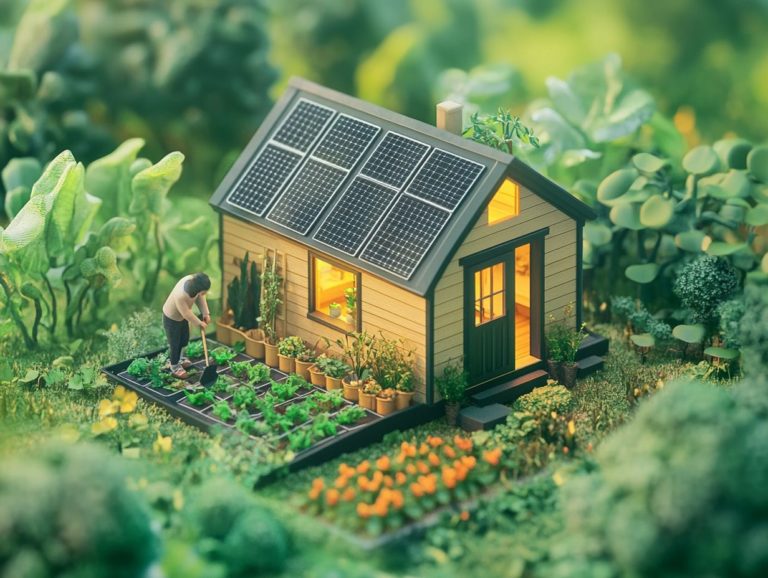The Best Natural Insulation Options for Tiny Houses
Ready to transform your tiny living space? Choosing the right insulation is key for both comfort and energy savings.
With an increasing focus on sustainability, many homeowners are turning to natural insulation options that conserve energy while reducing environmental impact.
This guide will explore some of the finest natural insulation materials available, ranging from wool and cotton to innovative solutions like mushroom insulation and recycled denim.
Uncover how these eco-friendly choices can elevate your tiny living experience while ensuring your space remains cozy and environmentally conscious.
Contents [hide]
- Key Takeaways:
- 1. Wool
- 2. Cotton
- 3. Hemp
- 4. Cork
- 5. Straw
- 6. Recycled Denim
- 7. Cellulose
- 8. Sheep’s Wool
- 9. Mushroom Insulation
- 10. Aerogel
- 11. Soy Foam
- 12. Linen
- 13. Recycled Newspaper
- 14. Sheep’s Wool
- 15. Polyurethane Foam
- Frequently Asked Questions
- What are the best natural insulation options for tiny houses?
- How does insulation affect energy costs?
- Is natural insulation better than synthetic options?
- How do these natural insulation options compare to traditional insulation materials?
- Are these natural insulation options more expensive?
- How do I know which natural insulation option is best for my tiny house?
- Can I use a combination of natural insulation materials?
- Are there any downsides to using natural insulation options for a tiny house?
Key Takeaways:
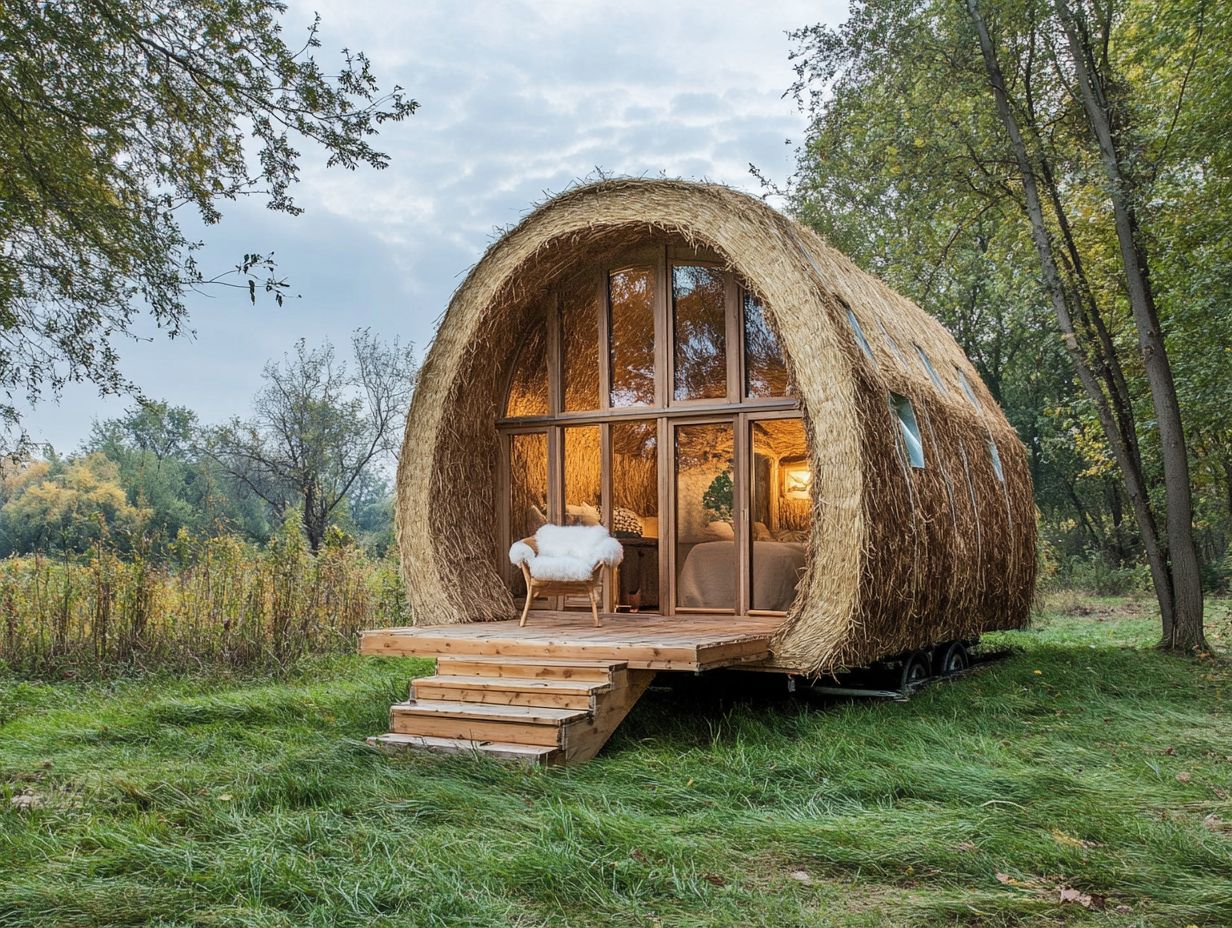
- Wool is natural, sustainable, and provides excellent thermal and sound insulation.
- Hemp is renewable, biodegradable, and has high thermal resistance.
- Cork offers versatile, eco-friendly insulation with great properties.
1. Wool
Wool insulation is an eco-friendly choice for your tiny house. It offers moisture resistance and improves energy efficiency.
With an R-value ranging from 3.6 to 4.2 per inch, wool is effective against synthetic materials like fiberglass, which may have higher R-values but come with environmental issues.
Wool regulates humidity levels, helping you maintain a comfortable indoor environment. This also reduces the chances of mold growth.
However, wool tends to be pricier than conventional insulation options. If not treated properly, it can attract pests.
Experts like Amanda Ringler emphasize the thermal performance of wool in tiny homes and its compliance with building codes. This proves that sustainable living can harmonize with regulations while ensuring comfort.
2. Cotton
Cotton insulation, often crafted from recycled denim, is an eco-friendly and energy-efficient choice. It excels in thermal regulation for tiny houses while resisting moisture.
This material features a commendable R-value, delivering solid resistance to heat flow, which is crucial for energy savings. Homeowners who prioritize sustainability will also appreciate its role in reducing landfill waste.
While the cost may vary, cotton insulation can be more expensive than traditional options. This could influence budget-conscious projects.
For those with a DIY spirit, cotton insulation is straightforward to handle and install, making it an attractive option for enhancing energy efficiency.
3. Hemp
Hemp insulation is becoming a sensation in tiny house construction for good reason. Its eco-friendly nature and exceptional energy efficiency make it a top pick for environmentally conscious homeowners.
With its impressive R-value, hemp insulation guarantees superior thermal performance. It helps maintain a stable indoor climate, reducing your need for excessive heating or cooling.
Unlike many traditional materials, hemp boasts remarkable moisture resistance. This effectively prevents mold and mildew while preserving your structure’s integrity.
When compared to alternatives like fiberglass or foam, hemp insulation shines not just in effectiveness but also as a renewable resource. It significantly lowers the carbon footprint tied to construction.
This blend of durability and sustainability makes hemp a savvy choice for anyone eager to minimize their environmental impact while enjoying lasting performance.
4. Cork
Cork insulation is a remarkable renewable material that provides energy-efficient insulation for tiny homes. It minimizes thermal bridging, which helps enhance your overall comfort and sustainability.
This versatile material boasts an impressive R-value, a measure of insulation effectiveness. It ensures your tiny home remains warm in winter and cool in summer. Its natural moisture resistance helps prevent mold and mildew, creating a healthier indoor environment for you and your loved ones. Additionally, exploring unique flooring options for tiny houses can enhance both comfort and style.
Beyond thermal performance, cork insulation shines in soundproofing, effectively dampening outside noise. This is a crucial feature for anyone seeking tranquility in compact spaces. Its eco-friendliness and renewable nature are significant advantages. However, it s wise to consider regional building codes and the initial cost compared to traditional insulation options before making a decision.
5. Straw

Straw bales present an innovative, eco-friendly insulation solution for tiny homes. They deliver impressive thermal performance with a high R-value and serve as a sustainable building material.
This natural option helps reduce your energy costs and fosters a healthier indoor environment. As you choose insulation, consider how straw performs compared to traditional options like fiberglass or foam, as it often outperforms them in energy efficiency.
As a potential builder, familiarize yourself with local building codes that may govern the use of straw. Proper installation and diligent maintenance are crucial to mitigate risks like mold growth.
Despite its myriad advantages, including an abundant supply and a low carbon footprint, you must consider challenges such as potential pest infestations and the necessary precautions against fire hazards.
6. Recycled Denim
Recycled denim insulation is a premium, eco-friendly choice that enhances energy efficiency. It excels in moisture resistance, making it ideal for those looking to minimize their carbon footprint, especially in tiny houses.
This innovative insulation material boasts an impressive R-value, typically ranging between R-13 and R-15. It competes directly with traditional options like fiberglass or foam. Homeowners and builders appreciate its ability to regulate temperature while minimizing noise, creating a serene indoor environment.
The versatility of recycled denim opens the door to various DIY projects, giving you the power to tackle home improvement tasks. You can ensure compliance with local building codes. Incorporating sustainable practices into your home design becomes achievable and deeply rewarding, offering significant economic and environmental benefits.
7. Cellulose
Cellulose insulation, crafted from recycled paper products, stands out as an eco-friendly alternative. It delivers exceptional energy efficiency and thermal performance for tiny homes, making it perfect for the environmentally conscious homeowner.
With an impressive R-value typically ranging from 3.2 to 3.8 per inch, cellulose insulation effectively resists heat flow. This makes it a top contender for your insulation needs. It excels at managing moisture and regulating humidity levels within your space.
However, improper installation could leave it vulnerable to mold. Its dense packing helps combat thermal bridging, significantly minimizing energy loss. For the DIY enthusiast embarking on a tiny house project, cellulose insulation is readily available and easy to install.
This makes it a favored choice for those dedicated to sustainability and looking to keep costs in check.
8. Sheep’s Wool
Sheep’s wool insulation is a great natural choice that excels in thermal regulation. It also boasts impressive moisture resistance, making it an exceptional choice for tiny houses.
This sustainable material features an outstanding R-value, a measure of insulation’s effectiveness at resisting heat flow. This significantly enhances your energy efficiency throughout the year.
By opting for sheep’s wool, you re not just making a smart choice for your home; you re also contributing to a lower carbon footprint. It s renewable, biodegradable, and sourced from sheep that thrive in a natural environment.
While the benefits are abundant like its soundproofing qualities and capacity to regulate indoor humidity you should also consider the building codes that may vary. Some regulations might introduce challenges due to the unique properties of wool, but with the right knowledge, you can often navigate these hurdles with ease.
9. Mushroom Insulation
Mushroom insulation is an innovative and eco-friendly building material that can enhance energy efficiency and provide effective thermal regulation for your tiny home. It s a standout choice for sustainable living.
This natural insulation boasts an impressive R-value, signaling superior thermal resistance. It also shines with remarkable sustainability features.
When you consider this material, you’ll appreciate how it’s derived from agricultural by-products, offering a renewable option that significantly reduces waste. Its moisture-resistant properties protect your space from mold and mildew, contributing to a healthier indoor environment.
If you enjoy hands-on projects, mushroom insulation can serve as an engaging DIY endeavor. It aligns with building codes while allowing you to flex your creativity in home improvement. With all these benefits, it s clear why many people are choosing this forward-thinking option.
10. Aerogel
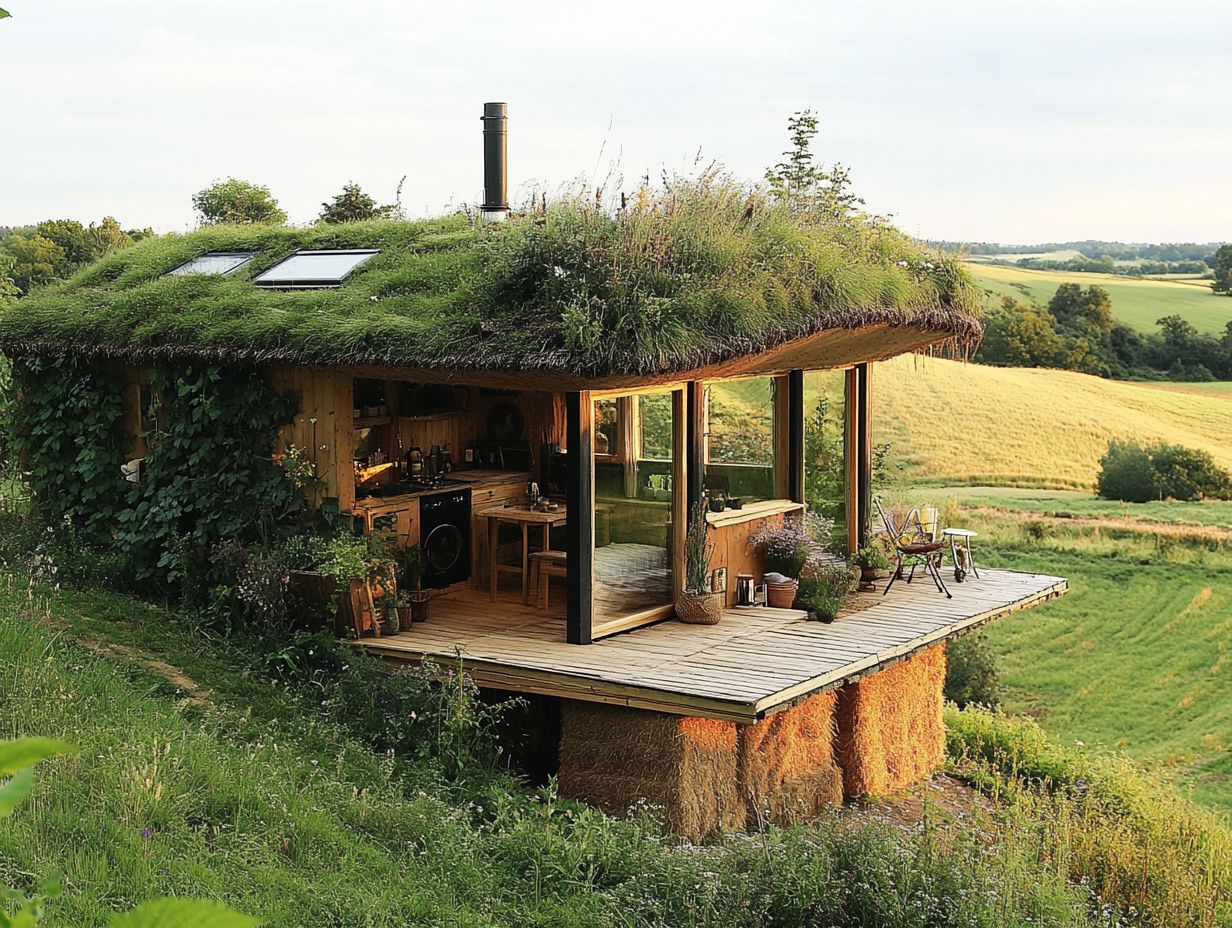
Aerogel insulation stands out as an advanced material, celebrated for its energy efficiency and exceptional thermal performance. It s perfect for tiny homes that require high-performance insulation solutions.
With a remarkable R-value that surpasses many traditional materials, aerogel enables you to design incredibly energy-efficient spaces without compromising on precious square footage. Plus, it s significantly lighter than conventional insulation options, which helps reduce structural loads an important factor in compact living environments.
Its impressive moisture resistance also mitigates risks of mold and mildew. This ensures your indoor air quality remains pristine. When you compare it to standard insulation materials like fiberglass or foam, aerogel’s unique properties align beautifully with modern building codes that prioritize sustainability and energy efficiency. This makes it an excellent choice for environmentally conscious projects.
11. Soy Foam
Soy foam insulation stands out as a premium eco-friendly alternative. It enhances energy efficiency and delivers exceptional thermal performance a remarkable choice for your tiny house construction.
This innovative insulation material boasts a high R-value, typically ranging from 5.0 to 6.5 per inch, far exceeding that of traditional fiberglass or cellulose. Its superior thermal resistance plays a crucial role in regulating indoor temperatures.
This ensures you enjoy a comfortable living environment throughout the year. Moreover, soy foam also offers impressive moisture resistance, significantly reducing the chances of mold and mildew growth and enhancing your indoor air quality.
If you’re inclined towards hands-on projects, the application of soy foam insulation is well-suited for DIY endeavors. This allows you to engage in your building projects while embracing the advantages of sustainable practices.
12. Linen
Linen insulation emerges as a sustainable and energy-efficient option, presenting unique thermal properties that make it an ideal choice for eco-conscious homeowners eager to reduce their carbon footprint.
This natural insulating material distinguishes itself with an impressive measure of how well insulation resists heat flow, showcasing its ability to maintain a comfortable indoor environment.
Unlike some conventional insulation materials, linen excels in moisture resistance, effectively preventing mold growth and contributing to a healthier living space.
While the benefits of linen insulation are significant, it is important to consider potential downsides, such as higher initial costs and limited availability compared to more common choices like fiberglass or foam.
When contemplating insulation for tiny houses, thoughtfully weighing these factors is crucial. The right selection can profoundly influence energy efficiency and overall living comfort.
13. Recycled Newspaper
Recycled newspaper insulation offers you an eco-friendly and energy-efficient solution tailored for tiny homes, harnessing sustainable materials to craft a comfortable living space.
This innovative material also features an impressive measure of thermal resistance, positioning itself as a serious competitor to traditional insulation options.
By effectively resisting moisture, it helps you maintain optimal indoor air quality and keeps mold growth at bay. You ll appreciate how it mitigates the risks of thermal bridging, ensuring a stable temperature throughout your home.
One of the most enticing aspects is the potential for DIY projects, allowing you to install it yourself. This not only cuts down on labor costs but also contributes to a greener planet.
This makes recycled newspaper insulation an accessible choice for enhancing your home s efficiency while providing a rewarding experience that fosters your sense of self-sufficiency.
14. Sheep’s Wool
Sheep’s wool insulation stands out as a natural, eco-friendly option that excels in thermal regulation and offers remarkable moisture resistance. This makes it an exceptional choice for your tiny house.
This insulation material boasts an impressive measure of thermal resistance, ensuring your home remains snug in winter and refreshingly cool in summer. This ultimately enhances your overall energy efficiency.
Its unique capacity to absorb and release moisture helps maintain a balanced indoor environment, significantly reducing the risk of mold growth a common concern in tightly sealed spaces.
From a sustainability perspective, opting for sheep’s wool can dramatically lower your building’s carbon footprint, aligning perfectly with green building standards. While you might encounter higher upfront costs and specific installation requirements, the long-term benefits think energy savings and a positive environmental impact often outweigh any initial concerns.
15. Polyurethane Foam
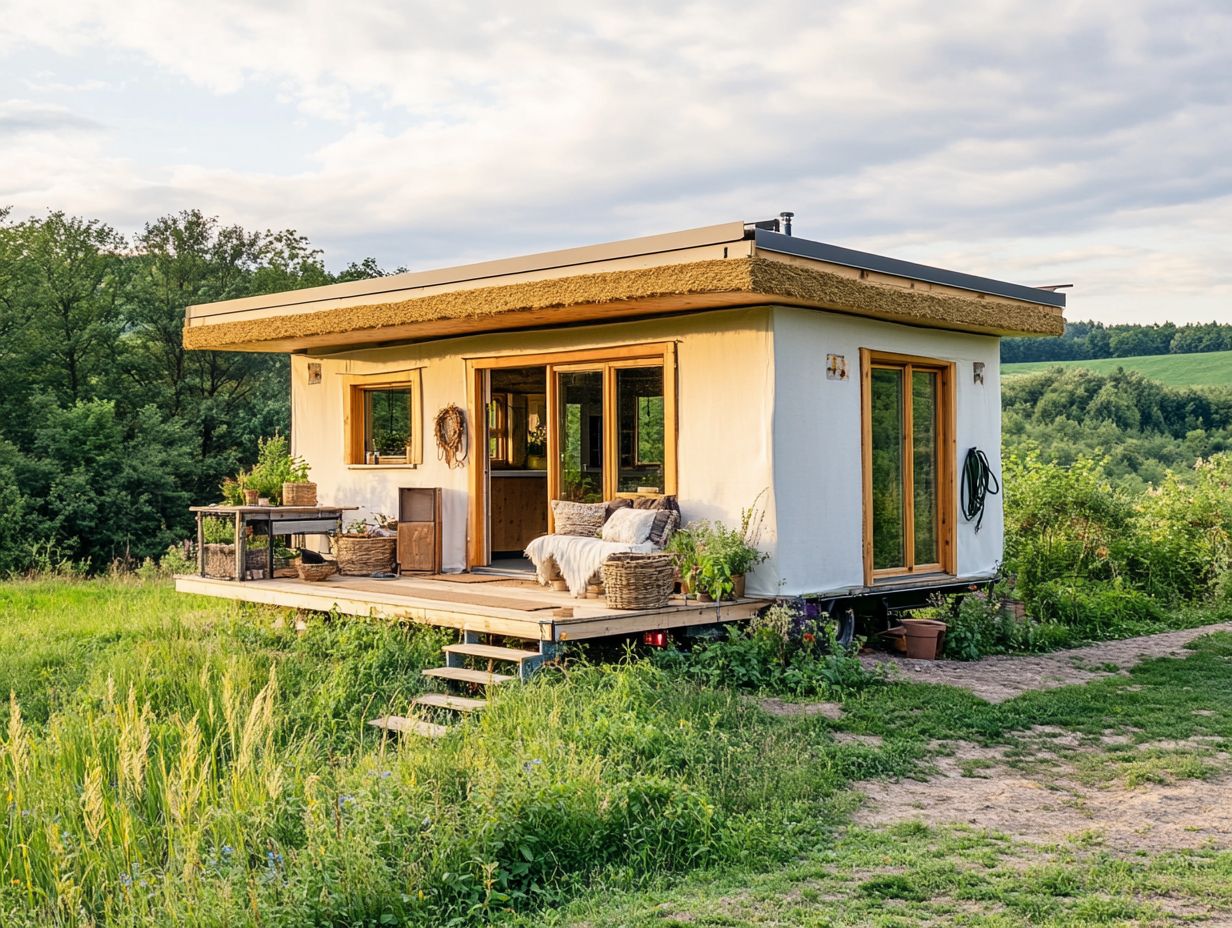
Polyurethane foam insulation, available in both closed cell and open cell variants, stands out as a highly energy-efficient material that delivers exceptional thermal performance for tiny homes.
Each type possesses distinct properties tailored to meet varying construction needs. Closed cell foam, with its dense structure, offers a higher measure of thermal resistance typically around 6 to 7 per inch making it the go-to choice for areas that demand significant insulation.
On the other hand, open cell foam, while presenting a lower measure of thermal resistance at about 3.5 to 4 per inch, shines in sound absorption and is lighter, which can be particularly advantageous in weight-sensitive designs.
The moisture resistance of closed cell foam makes it an excellent fit for high-humidity climates, whereas open cell foam promotes better air circulation, essential for maintaining indoor air quality in compact living spaces.
Frequently Asked Questions
What are the best natural insulation options for tiny houses?
Some of the best natural insulation options for tiny houses include materials such as wool, cotton, hemp, and cork.
How does insulation affect energy costs?
Proper insulation can significantly lower energy costs by reducing the need for heating and cooling, thereby creating a more energy-efficient home.
Is natural insulation better than synthetic options?
Natural insulation materials often provide superior moisture regulation and sustainability, making them an excellent choice for eco-conscious homeowners.
How do these natural insulation options compare to traditional insulation materials?
Natural insulation materials are generally more environmentally friendly and non-toxic than traditional options like fiberglass, a material made from tiny glass strands, and foam, which is often petroleum-based. They also offer excellent insulation properties and help regulate temperature and moisture levels in a tiny house.
Are these natural insulation options more expensive?
Some natural insulation materials may be slightly pricier than traditional ones. However, their long-term benefits and cost savings make them a smart investment for your tiny house.
Plus, many natural materials are easy to find or can even be made at home, making them more affordable for your project.
How do I know which natural insulation option is best for my tiny house?
The ideal natural insulation option for you depends on your local climate, budget, and personal values. Do some research, and don’t hesitate to consult a sustainable building expert for tailored advice!
Can I use a combination of natural insulation materials?
Feel free to mix and match different natural insulation materials to create the perfect fit for your tiny house! For example, you could use wool in the walls and hemp in the floors for comprehensive insulation.
Are there any downsides to using natural insulation options for a tiny house?
Some natural insulation materials may require more maintenance or replacement over time than traditional options. Additionally, not all natural materials may be readily available in certain areas, so keep this in mind when selecting your insulation materials.



